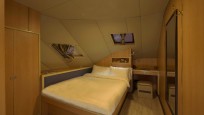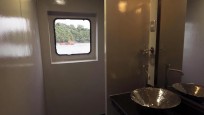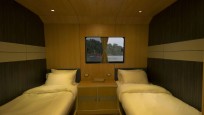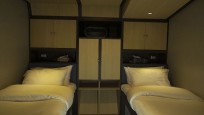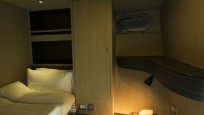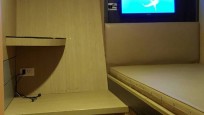Panunee
- Nitrox
- Internet
- PADI
- Camera Station
- Charging Station
- Massage
Panunee Yacht is a world-class aluminum steel-hulled motor yacht. She is 42 meters in length and 8 meters in beam. She accommodates 22 guests in 2 suite cabins, 8 deluxe cabins and 2 single-bed cabins. She is designed in ways to best meet the divers and underwater photographer’s needs and to make every trip a memorable one.
The Panunee cruises Indonesia’s top dive areas such as Komodo, Banda Sea, Raja Ampat and Cenderawasih bay.
The dive deck is quite roomy, with individual spaces helping to avoid congestion, and features a camera table and separate rinse tanks and air hoses for photographic equipment.
Accommodation
-
1 Suite Room
The 2 Suites are fitted with a queen-size beds, en-suited toilets with hot showers, individual air-conditioners, wardrobes,working desks, reading lights, wide storage space and pipe-in music.
-
2 Deluxe Twin Room
8 Cabins are fitted with twin beds and individual air-conditioners, wardrobes, mirrors, reading Lights, wide storage space, panoramic windows and pipe-in music. (common shower/toilet)
-
3 Deluxe Single Room
2 Single cabins are fitted with one single bed and individual air-conditioners, wardrobes, mirrors, reading Lights, wide storage space, panoramic windows and pipe-in music. (common shower/toilet)
Dining
A large indoor dining room is located on the rear deck, The cusine is varied with Indonesian, Asian and Western selections, cooked fresh every day with locally sourced ingredients, and freshly prepared bread and pastrie, to suit every taste. All meals are buffet style.
Bottled soft drinks are free throughout the trip.
Vegetarian and Special dietary menu available on request.
Diving
Panunee offers wide dressing and individual storage areas. 5 rinse hosts are located at the platform. A large dive deck contains 30 fully filled tanks supported by 3 Bauer air compressors and 3 dinghies with 40 H.P. outboard each. Nitrox (blending system) is also available. The wide platform is designed for more convenient dive entry and exit.
- Nitrox per Dive 12$
Dive Courses
Panunee offers PADI dive courses and introductory dives.
Contact Us for mor info and rates.
- PADI Discover Scuba Diving
- PADI Open Water
- PADI Advanced Open Water
- PADI NItrox Course
Equipment Rental
Equipment rental prices are based per day.
- Full set 40$
- Regulator 10$
- BCD 10$
- Wetsuit 8$
- Dive Computer 10$
- Fins 10$
- Snorkeling equipment 10$
- 15 liters tank 12$
Facilities
- Restaurant
- Bar
- Camera Room
- Charging Station
- Camera Rinse Tank
- Air Conditioned Saloon
- Outdoor Saloon
- Sun Deck
- Shaded Deck Area
- Dive Deck
- Dry Suit Diver
- Dive Tenders
Services
- Daily Housekeeping
- Laundry Service
- Massage
- Audio & Video Entertainment
- Tours
Activities
A remote perfect beach, visiting a traditional village or a pearl farm, trekking up a hill for a breathtaking view. There is plenty of possibilities for memorable encounters and moments beyond the daily in-water activities. Almost every day we enrich our program to offer the most.
Boat Features & Safety Equipment
| Hull |
Aluminium & Steel |
| Length | 42 Meters |
| Beam | 8 Meters |
| Draft Design | 3.5 Meters |
| Gross Tonnage | 221 |
| Maximum Speed | 15 Knots |
| Engine |
x 2 , MAN 760HP |
| Gear | x 2 Nikko4-1 |
| Generator |
x 3 (100 KWA x 2) |
| Water Capacity | 20000 Liters |
|
Desalination machine |
x 2, Capacity of daily fresh water production = 8000 Litres |
| Fuel Capacity | 15000 Liters |
| Crew | 10 |
| Passengers | 22 |
|
GPS |
Yes |
| Sounder | Yes |
|
Satellite navigation |
Yes |
| Communication |
VHF, HF, SSB, Satellite phone |
| Safety Equipment | 2 life rafts, Life jackets, Fire extinguishing, DAN Oxygen kit, First aid kit, Dive support boat (Dinghy) x 2 with 40 HP Yamaha outboard |
Cruise Price Includes
Full board meals including water and hot drinks.
Multilingual cruise director on board
Diving services including tanks, weights, fills, guides and dive tenders.
All offered excursions
Cruise Price Excludes
Round trip airport transfer fees
Possible fuel surcharge
Dive gear rental
Beer, Wine and Spirits
Marine Park fees
Port/Harbour fees
Komodo-Maumere - USD 210
Maumere-Alor-Banda-Ambon - USD 300
Ambon-Banda sea - USD 250
Ambon-Banda-Raja Ampat - USD 300/
Raja Ampat - USD 270
Cenderawasih - USD 230
-
Komodo
The Komodo National Park is a national park in Indonesia consisting of the three large islands; Komodo, Padar, Rinca and 26 small ones. The national park was founded in 1980 to protect the Komodo dragon, the world's largest lizard. Later it was dedicated to protect other species, including marine species. In 1991 the national park was declared a UNESCO World Heritage Site. It has been selected as one of the New 7 Wonders of Nature. The climate is oe of the driest of Indonesia with annual rainfall. Dry season is from May to October. In the north of the park, water temperature ranges between 25-29 C. In the middle, the water temperature ranges between 24-28 C and the South, the water temperature ranges between 22-28 C. The visibility is very quite clear.
Komodo National Park includes one of the world's richest marine environments. It consists of forams, cnidarian (includes over 260 species of reef building coral) , sponges, marine mammals (dolphins, whales, and dugongs) , Napoleon wrasse and groupers.Dive site
Bidadari Island :
The location consists of huge towers of stone covered with hard / soft corals. There are a lot of nudibranches, dusky sharks, bumphead parrot fishes. A gentle slope covered with every color of table corals. There are some small caves where are the home of some huge lobsters
Sebayour :
It is good dive spot for checking dive. The location is slope and sandy area continuing to ridge. There are a lot of macro fish like jawfish, bubble coral shrimps, leaffish, porcelain crabs. There are also plenty of schools of fusiliers, bumhead parrotfishes, red tooth triggerfishes and jack fishes.
Castle Rock:
Approx. 20-30 m depth. There are numerous seafans where are home of pygmy seahorses. The fish life here is simply stunning with school of barracudas, trevally, and mackerel. Also white tips, black tips, gray reef sharks, and the visibility is excellent.
Crystal Rock :
The rock is submerged at high tide and exposed at low tide. The best time to dive there is during slack tide. Big fishes come with some current. The water is very clear. The shallows host colorful Anthias , damselfish, pyramid butterfly fish, turtles and large octopus. For macro critters, nudibranches and frogfish are often seen.
Tatawa Besar :
The dive area is fringing reef and steep banks with turtles. There are several coral caves. There are a lot of fish like schools of sweetlips. Sharks and turtles are very common. Manta's sometimes come to this area also. The best way to dive here is to drift with the current along the northeastern side and end up on the corner for safety stop.
Tatawa Kecil :
This is a small rocky island consisting of very large boulders and rocks to the west. All covered with orange cup corals. The best time to dive here is during slacktide. There are many coral reef fishes including large groupers, snappers, sweetlips, jacks and shakrs. Gugong sometimes can be seen.
Batu Bolong :
It is a small rocky island. Diving can be done during only slack tide. This area is unharmed by fisherman because the typical of the location where is steep walls does not allow them to use dynamite and cyanide fishing techniques. The area are covered by colorful corals and thousands of small colorful fish. It is needed to strictly dive in this area. Divers must follow the dive guide to avoid the getting suck down to the deeper level.
Wainilu :
It is good to visit macro marine life here. There are a lot of nudibranches, banded pipefishes, mandarin fishes, Wonderpus, Indian walkman, frogfishes, and harlequin sweetlips. .Some divers call this area as " Little Lembeh" .
Cannibal Rock :
There are both hard and soft corals . It is very abundant and worth to do several dives. We can se several species of unusual nudibranches, zebra crabs, and frogfishes. The top of the reef is covered by anemones with different species of sea anemone fishes. Diving here is easy because of little current.
Yellow Wall :
It is covered by large yellow soft coral ... that's why it is called Yellow Wall. The water temperature is very cold because of upwelling from deep in the ocean south of Rinca. Uncommon speciesof nudibranchs ccoleman shrimp are attractive.
Manta Alley :
It is very famous dive site to see Mantas. They can be found through the site. In addition, there are schools of bumphead parrot fish, bamboo sharks, and marble rays. -
Banda
The Banda islands are an archipelago in South Maluku , Indonesia. It is also known as “ Spice islands” of anchient times. There are seven main islands ; consisting of Banda Neira, Banda Besar, Pulau Ai, Pulau Run, Pulau Pisang and Pulau Hatta , and numerous smaller islets that create the great diving points. Banda islands are located about 132 kilometers southeast of Ambon. With multi-colored reefs, warm seas and exotic marine life, the Banda’s are a heaven for divers who explore the most remote and unspoiled dive sites in the world. The Banda islands are one of the most popular destinations for divers. The diving spots are varied from the shallow lagoon between Banda Neira and Gunung Api, to the vertical walls of Hatta island. The remoteness of the islands in the wide open Banda sea and the low levels of human population, have meant less fishing pressures, and a vibrant, natural and healthy reef system. The results of this are fishes in incredible numbers, huge seafans and sponges, and some monumental hard corals You can see napoleon wrasse, giant groupers, dogtooth tuna, mobula rays, whales , dolphins and much more.
Dive sites
Banda Neira :
It is the capital of the Banda islands and the one of the ten volcanic islands in the Banda Archipelago. You can muck dive with flying gurnards, sea moths, mandarin fish and nudibranches
Suanggi :
The seascape is plenty of various kinds of unspoiled hard and soft corals reef. You can see snapper, bumphead, blunthead parrotfish, turtles and sharks
Batu Kepal :
It is a pinnacle. The shallow at the peak on the west of the main rock is 8 meters depth. It is easily seen from surface. It is connected to the next deeper rock to the north. Between the shallow and deeper sites, there is a valley going down to 50 Meters depth. You can see the biggest red tooth trigger fish and large moray eels. A channel with some boulders is at the east of the Batu Kepal. At the wall of this channel is very colorful and rich in fish and invertebrate species. The visibility is 40-50 meters.
Lava Flow :
It is located in the north of Gunung Api (one of ten volcanic islands in the Banda Archipelago) where volcano forms a small round island built by lava flows. rising 5 km from the sea floor until 282 meters above water. After the volcano erupted in 1988, the bottom of this dive site was covered by lava. Corals started to quickly grow on the cold lava. There is a flourishing , vast carpet of staghorn coral, plate corals and table corals now growing where the lava once flowed.
Htta Island :
25 km from Banda Neira. Skaru Atoll, is the name of a coral, few hundred yards south of the island, there is some colony of unicorn fish, Fusiliers, jacks fish and rainbow runners, white-tip sharks measuring almost two meters, napoleon wrasse, dogtoothed tuna, and turtles.
Manuk island :
The reefs are very healthy with cabbage corals, and sponges .
Pohon Miring :
It is wall dive with gentle currents. There are larger fish such as tuna, bumphead parrotfish, and napoleon wrasse.
Ai :
It is located on the west of Banda Neira. It is the top dive site for shark encounter, especially Hammerhead sharks, thresher and silvertip sharks
Run :
It is a small island which is full of colorful wall and large amounts of fish. The main wall lays 70m to 150m off the islands’ northwestern coast known as “Depan Kampung” . -
Cenderawasih Bay
Along coastal area of Papua where resembles the shape of a large bird’s head, The 1,453,500 hectare Cenderawasih Bay National Park is located in the western part of the bay. The Decree of Ministry of Forestry No.472/Kpts-II/1993 declared the park as a Marine National Park on 2nd September 1993. 95 percent of total area is waters (coral and seas) and the rest covers large mainland occupying 68,200 hectares (islands and coast line). Here are magnificent vertical drops, picturesque hard coral gardens, sponge life and myriads of fish. Dr.Gerald Allen ; scientist, calls the Cenderawasih Bay as “ The Galapagos of Indonesia’s Reefs”. There are varieties of abundant coral reef (fringing reef, barrier reef, atoll, patch reef and shallow water reef) which is indeed the last of the few remaining pristine reefs in the world.
Over 10,000 years after Pleistocene age, the sea level was come up again and it brought the deep dwelling marine critters from deeper level to shallower level. Other normally deep dwelling marine critters can be seen in the shallower level in Cenderwasih such as Ornate Angelfish , Randall’s Anthias, and Burgess Butterfly fish. These fish are generally found below 50 Meters throughout the rest of their range, but can frequently be seen at depth between 20-30 meters in Cenderawasih.
In addition, because of the landscape of the bay, it is prevented from outside current. Therefore, the marine critters in here are very unique. Besides, more than 500 species of hard coral in Cenderawasih bay, nearly 10 times of Caribbean sea, are found and at least 30% of them have not yet been described. Moreover, 15 of fish species found abundantly on its reefs are found nowhere else on the planet, and a number of others have unusual color morphs that are completely different to those found outside the bay.
Dive site
Kawatisore Bay :
From time to time at the horizon of Kawatisore village, a big community of whalesharks (known in local name as Hiniotanibre) are surrounding the floating fishing platforms (known in local name as “ Bagan” ) Waiting for their favorite anchovies buffet throughout the day. The fishermen believe that their gentle giant friends are bringing the good luck to them, therefore they keep some alive anchovies in their fishing nets for their gentle giant friends who always fall in food temptation and keep closing to the floating fishing platforms.
Other dive sites :
There are another 20+ dive sites from the Pulau Purup in the northwest down to Mioswaar, Roon until
Kawatisore in the south of the bay. The historical geology in here creates the unique underwater critters and environment. Starting from shallows to 40 meters, there several species of fusiliers , schooling red-tooth triggerfish, giant trevally , a mix of reef sharks.
At Tanjung Ayami , it is located on the northeast of Pulau Roon, it is a long ridge of hard coral with few sea fans and soft corals. There is a channel with white sand at the bottom inside the channel, schools of barracuda and fusiliers or even “ wunderpus octopus” are found there.
At Numamuran Strait – at 12 meters on hard coral slope at west side of Pulau Rippon, there is a Zero WWII airplane is resting. After the slop steepens, there are some nice sea fans and soft corals. At 25 meteres , there are small coral islands covered by masses of soft corals, sea fans, whips, elephant ear sponges on white sandy bottom. There are not only wide subjects like green turtles, barracuda and surgeonfish, but also macro subjects such as ribbon eels, and uncommon gobies. Bommies surrounded by fusiliers. The more strengthencurrent, the more marine life are coming.
At Crissy’s Delight in the east Wandammen Peninsula , it is good for macro critters such as small cuttlefish, ghost pipefish, tiger shrimp , allied cowries and nudibranchs.
At Tanjung Mangguar – It is one of the most beautiful and attractive dive sites in Cenderawasih area. The abundance of soft coral and sea whip attracts large numbers of fish such as schools of barracuda, rainbow runners and travelley. Moreover, sharks, mantas and mobular rays are common in this area. Night dive here is very fantastic. With the sea grass at the bottom, orange frogfish , Pegasus sea moths, various nudibranches , and much more in front of the village where the stream flows into the bay.









